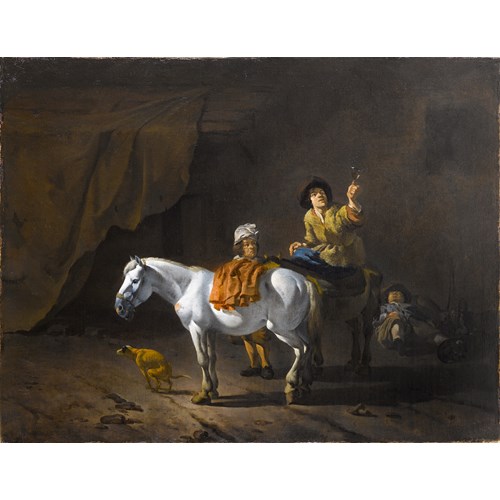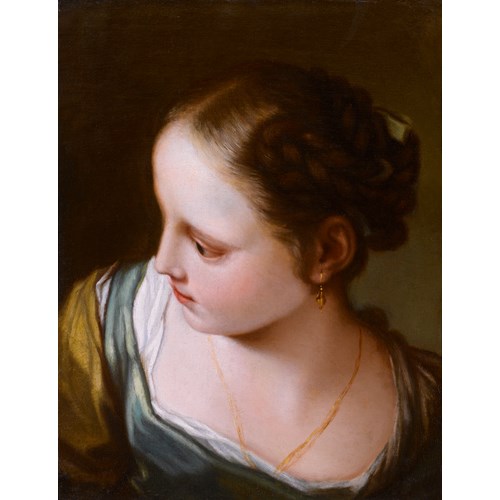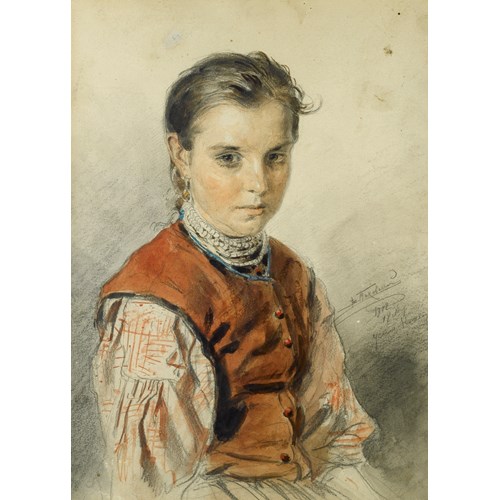Marketplace
A Forest Floor Landscape with a Thistle, Fungi, Moths, a Lizard and Snakes
Elias van den Broeck
A Forest Floor Landscape with a Thistle, Fungi, Moths, a Lizard and Snakes
Period 1600-1750, 17th century
Origin Belgium, The Netherlands
Medium Oil on canvas
Dimension 37.4 x 29.9 cm (14³/₄ x 11³/₄ inches)
A Forest Floor Landscape with a Thistle, Fungi, Moths, a Lizard and Snakes is a fine example of Elias van den Broeck’s characteristic still life paintings of insects, reptiles and amphibians set amidst the flora of a forest floor. The work reveals van den Broeck’s expertise in combining scientific accuracy in observation with a harmonious balance of colour and composition, narrative and symbolism.
The arresting image of two snakes attacking each other, one opening its jaws to swallow the other, dominates the painting. They are intertwined around a thistle, at the base of which a menacing clump of fungi grows. A lizard creeps along the mossy ground and several butterflies flutter about, mostly congregating near the central purple flower of the thistle. The plant is spot lit and around it a dense forest recedes into the darkness. The composition is very similar to Still Life with Snake by van den Broeck in the Ashmolean Museum, Oxford, which is also centred on a flowering thistle plant with butterflies hovering and fungi growing nearby. The snake in this image has reared up ready to lunge at a grasshopper. A snail slimes its way along the ground and another settles on a leaf, while a mouse shelters in the foliage.
A Forest Floor Landscape with a Thistle, Fungi, Moths, a Lizard and Snakes, like most of van den Broeck’s paintings, has a definite narrative element, provided in this case by the interaction between the two snakes. The image reveals as much of an interest in representing the ways animals interact as recording their appearance. It is probable that van den Broeck’s selection of reptiles and plants was not made merely out of zoological and botanical interest, but because of their symbolic and religious associations. The lizard and snakes are the ‘abominations’ of the Old Testament: ‘And every creeping thing that creeps on the earth shall be an abomination...Whatever crawls on its belly, whatever goes on all fours, or whatever has many feet among all creeping things that creep on the earth’ (Leviticus 11:41). The snake has the added ignominy of being the recipient of God’s curse after the Fall of Man: ‘cursed are you among all animals and among all wild creatures; upon your belly you shall go, and dust you shall eat all the days of your life’ (Genesis 3:14). The thistle also has religious connotations, its spines being linked to Christ’s crown of thorns and therefore his suffering, sin and sorrow. The profusion of butterflies gives the painting a hopeful and redeeming note, not only in their brightness and beauty but also as Christian symbols of the resurrection.
The subgenre of reptile, insect and plant paintings, that the current work fits into, was developed by Otto Marseus van Schrieck. In order to achieve greater realism, van Schrieck sometimes made an impression of the wings of butterflies and other insects into the paint, or attached them to the canvas. This was a technique also adopted by van den Broeck, to enhance the beauty and permanence of his creations, however in almost all cases the wings have disappeared and been painted in by a later hand.
Van den Broeck was born in Antwerp, and moved at an early age to Amsterdam, where he was apprenticed to a goldsmith in 1665. He also studied under Cornelis Kick, a still-life painter, until 1669, after which he became a studio assistant to Jan Davidsz de Heem, one of the most influential exponents of seventeenth-century Netherlandish still life painting. It seems that van den Broeck followed de Heem when he returned to Antwerp in 1672, and a year later became a member of the guild there. In 1685 he returned to Amsterdam, where he settled permanently.
The present work has been examined and authenticated by Fred Meijer of the RKD.
The arresting image of two snakes attacking each other, one opening its jaws to swallow the other, dominates the painting. They are intertwined around a thistle, at the base of which a menacing clump of fungi grows. A lizard creeps along the mossy ground and several butterflies flutter about, mostly congregating near the central purple flower of the thistle. The plant is spot lit and around it a dense forest recedes into the darkness. The composition is very similar to Still Life with Snake by van den Broeck in the Ashmolean Museum, Oxford, which is also centred on a flowering thistle plant with butterflies hovering and fungi growing nearby. The snake in this image has reared up ready to lunge at a grasshopper. A snail slimes its way along the ground and another settles on a leaf, while a mouse shelters in the foliage.
A Forest Floor Landscape with a Thistle, Fungi, Moths, a Lizard and Snakes, like most of van den Broeck’s paintings, has a definite narrative element, provided in this case by the interaction between the two snakes. The image reveals as much of an interest in representing the ways animals interact as recording their appearance. It is probable that van den Broeck’s selection of reptiles and plants was not made merely out of zoological and botanical interest, but because of their symbolic and religious associations. The lizard and snakes are the ‘abominations’ of the Old Testament: ‘And every creeping thing that creeps on the earth shall be an abomination...Whatever crawls on its belly, whatever goes on all fours, or whatever has many feet among all creeping things that creep on the earth’ (Leviticus 11:41). The snake has the added ignominy of being the recipient of God’s curse after the Fall of Man: ‘cursed are you among all animals and among all wild creatures; upon your belly you shall go, and dust you shall eat all the days of your life’ (Genesis 3:14). The thistle also has religious connotations, its spines being linked to Christ’s crown of thorns and therefore his suffering, sin and sorrow. The profusion of butterflies gives the painting a hopeful and redeeming note, not only in their brightness and beauty but also as Christian symbols of the resurrection.
The subgenre of reptile, insect and plant paintings, that the current work fits into, was developed by Otto Marseus van Schrieck. In order to achieve greater realism, van Schrieck sometimes made an impression of the wings of butterflies and other insects into the paint, or attached them to the canvas. This was a technique also adopted by van den Broeck, to enhance the beauty and permanence of his creations, however in almost all cases the wings have disappeared and been painted in by a later hand.
Van den Broeck was born in Antwerp, and moved at an early age to Amsterdam, where he was apprenticed to a goldsmith in 1665. He also studied under Cornelis Kick, a still-life painter, until 1669, after which he became a studio assistant to Jan Davidsz de Heem, one of the most influential exponents of seventeenth-century Netherlandish still life painting. It seems that van den Broeck followed de Heem when he returned to Antwerp in 1672, and a year later became a member of the guild there. In 1685 he returned to Amsterdam, where he settled permanently.
The present work has been examined and authenticated by Fred Meijer of the RKD.
Period: 1600-1750, 17th century
Origin: Belgium, The Netherlands
Medium: Oil on canvas
Dimension: 37.4 x 29.9 cm (14³/₄ x 11³/₄ inches)
Provenance: Anonymous sale, Beaussant Lefèvre, 5th November 2007, lot 83, as Otto Marseus van Schrieck.
More artworks from the Gallery




 A Woman Bending forwards in Work, and_T638856835938571470.jpg?width=500&height=500&mode=pad&scale=both&qlt=90&format=jpg)




